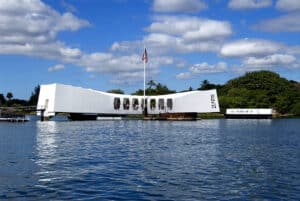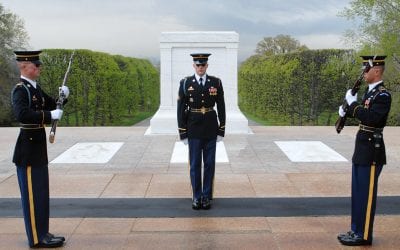Travel to these four remarkable, historic U.S. military sites for future Veterans Day holidays. Honor and learn about our extraordinary service men and women.
 U.S. Veterans Day is today, November 11th. World War I ended on the 11th hour of the 11th day of the 11th month of 1918 when Germany signed the Armistice with the Allies. It was first called Armistice Day but renamed Veterans Day at the urging of U.S. veterans’ organizations.
U.S. Veterans Day is today, November 11th. World War I ended on the 11th hour of the 11th day of the 11th month of 1918 when Germany signed the Armistice with the Allies. It was first called Armistice Day but renamed Veterans Day at the urging of U.S. veterans’ organizations.
Veterans Day gives each American a special opportunity to not just honor the memory of our service men and women who gave their lives for us. The holiday also honors living veterans who likewise fought to ensure our nation’s safety and freedom.
Honor American veterans by journeying to these historic sites across the U.S. to learn about their stories.
By the time you will have read this column, I will have traveled to Washington Square, Philadelphia, to the “Tomb of the Unknown Revolutionary War Soldier.” There in the shadow of Independence Hall, an eternal flame burns in perpetual vigilance. On the memorial it says,
“Freedom is a light for which many men have died in darkness.”
There are many travel opportunities in the United States to visit and learn about the rich fabric of general and military U.S. history. Visit battlefields, military encampments, and military cemeteries across the nation where too many of our fallen heroes lie for eternity.
Here’s my Veterans Day list of four historic military sites that I recommend every American visit at some time in their lives while traveling the country.
Arlington National Cemetery is the most famous military cemetery in the U.S.
Arlington National Cemetery and the Tomb of the Unknowns — The Arlington National Cemetery in Arlington, Virginia, just across the Potomac River from Washington, DC, is the United States’ most famous military cemetery. The cemetery was established on May 13, 1864, during the American Civil War, on the grounds of Arlington House. This was the former estate of the family of Confederate General Robert E. Lee’s wife. Mary Anna (Custis) Lee was a step-great-granddaughter of George Washington. The 624-acre cemetery is the final resting place of more than 14,000 veterans and military casualties from each of the nation’s wars, ranging from the American Civil War to military actions of the present day.
There are many special memorials and graves of particular historic interest at Arlington. They include The Rough Riders Memorial, the Nurses Memorial, the Battle of the Bulge Memorial, Chaplins Hill, the Space Shuttle Columbia and Challenger Memorials, and the grave of President John F. Kennedy. Just outside the confines of Arlington is the U.S. Marine Corps War Memorial showing the raising of the flag at Iwo Jima.
The Tomb of the Unknowns, a monument dedicated to American service members who have died without their remains being identified, is within Arlington National Cemetery. It is popularly known as the “Tomb of the Unknown Soldier.”
A special platoon of the 3rd US Infantry Regiment guards the Tomb 24/7, every day of the year. There is a moving “Changing of the Guard” ceremony conducted at the Tomb every half hour during summer months, and every hour during winter months, during daylight hours. In the evening, the guard is changed every two hours.
The USS Arizona Memorial is undoubtedly the most hallowed naval memorial in the U.S.
USS Arizona Memorial — “Yesterday, December 7, 1941 — a date which will live in infamy. . .” President Franklin D. Roosevelt’s speech began when he asked the U.S. Congress to declare war against the Empire of Japan. Japan’s surprise attack on the U.S. Navy’s base at Pearl Harbor, Hawaii, was made by 353 Imperial Japanese Naval aircraft. In the attack, more than 2,400 military personnel and civilians were killed and many others wounded. Four battleships were sunk, and four others damaged. Sixteen other U.S. Navy ships were sunk or damaged. More than 300 U.S. military aircraft were destroyed or damaged.
The USS Arizona, sunk during the battle, serves as the final resting place for many of the battleship’s 1,177 crew members who lost their lives on that day at Pearl Harbor.
Looking down at the Arizona from the Memorial floating above, the barbette of one of the gun turrets remains visible in the water. Oil can still be seen rising from the Arizona’s wreckage to the surface of the water. Some swear you can still smell the battle in that oil as you survey the harbor.
When visiting the Memorial for the first time, I was awed, struck by the eerie quiet among the memorial’s visitors, even children.
No battles were fought at Valley Forge. The Continental Army’s encampment there in the brutal winter of 1777-78 clearly showed General Washington’s army’s mettle and perseverance.
Valley Forge National Historical Park – During the American Revolutionary War, no battle was fought at Valley Forge, but the Continental Army encampment was nonetheless instrumental in the American victory over the British. Valley Forge (just 25 miles from historic Philadelphia) was the site of the 1777-78 winter encampment of the Continental Army, led by General George Washington. The sacrifice and perseverance of the men encamped during that brutal Philadelphia-area winter of alternating freezing and melting snow and ice, which made it impossible to keep dry, brought honor to themselves during the extraordinary birth of the U.S.
When visiting Valley Forge. Men slept in cold and damp. Overcast days and winds added to suffering in winter. It’s easy to imagine the harsh conditions.
The wind and snow swept across fields, and men in cold, dank, often disease-ridden, log huts with but a hint of daylight in them.
Gettysburg’s battlefield was the Civil War’s bloodiest. The armies of the North and South suffered more than 50,000 combined casualties.
Gettysburg National Military Park – This year marked the 161st anniversary of the Battle of Gettysburg. The battle was a major turning point of America’s Civil War. A Union victory at Gettysburg ended General Robert E. Lee’s second and most ambitious invasion of the North in 1863. The battle was the war’s bloodiest, with more than 50,000 combined casualties, including almost 8,000 killed.
The eerily named Cemetery Ridge, Pickett’s Charge, and Little Round Top were all added to America’s lexicon during the Battle of Gettysburg. President Abraham Lincoln dedicated the Soldiers’ National Cemetery four months after the battle ended with his historic, famous Gettysburg Address.
The sprawling fields of the Gettysburg battlefields are located approximately 140 miles west of Philadelphia. You clearly understand how the three bloodiest days of the Civil War unfolded.
When making a journey to these locations, we can begin to understand the dedication, honor, and service those men and women gave the nation and the human cost of war with the tragic losses of those in service and the sacrifice of their families.
(Image: Arizona Memorial, Pearl Harbor, Hawaii. Copyright © 2024 NSL Photography. All Rights Reserved. All TDM and AI Training are Prohibited.)
READ ALSO:
Airport lounges are big business — they bring in loads of cash
On Monday, it’s Veterans Day, a time to remember
After many years working in corporate America as a chemical engineer, executive and eventually CFO of a multinational manufacturer, Ned founded a tech consulting company and later restarted NSL Photography, his photography business. Before entering the corporate world, Ned worked as a Public Health Engineer for the Philadelphia Department of Public Health. As a well known corporate, travel and wildlife photographer, Ned travels the world writing about travel and photography, as well as running photography workshops, seminars and photowalks. Visit Ned’s Photography Blog and Galleries.



